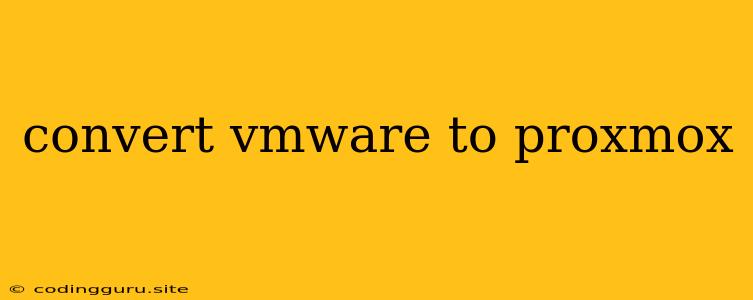Migrating Your Virtual Machines from VMware to Proxmox: A Comprehensive Guide
Moving your virtual machines from VMware to Proxmox can be a daunting task, but it can also be a rewarding experience, offering you a more flexible and cost-effective virtualization solution. Whether you're driven by budget constraints, a desire for greater control, or simply seeking a more feature-rich environment, Proxmox provides a compelling alternative to VMware. This guide aims to walk you through the process of migrating your virtual machines, addressing the key challenges and providing practical solutions.
Why Migrate to Proxmox?
Proxmox VE is a powerful and feature-rich open-source virtualization platform built on Debian Linux. It offers a comprehensive set of tools for managing virtual machines, containers, and storage. Here are some key reasons why you might consider migrating from VMware to Proxmox:
- Cost-Effectiveness: Proxmox is free and open-source, eliminating the licensing costs associated with VMware.
- Flexibility: Proxmox offers a highly flexible environment, allowing you to customize and configure your virtualization infrastructure to your specific needs.
- Community Support: Proxmox benefits from a large and active community, providing ample support resources and a wealth of knowledge.
- Feature Richness: Proxmox includes a wide range of features, including live migration, high availability, and advanced networking capabilities.
Planning Your Migration
Before embarking on your migration journey, meticulous planning is crucial for a smooth transition. Here are some essential steps to consider:
- Assess Your Environment: Carefully evaluate your existing VMware infrastructure, including the number and types of virtual machines, storage requirements, and network configuration.
- Choose a Migration Method: There are several approaches to migrating your VMs, including:
- Live Migration: This method allows you to migrate running VMs without downtime, ensuring uninterrupted operation.
- Offline Migration: This approach involves shutting down the VMs, exporting their configuration and data, and importing them into Proxmox.
- Prepare Your Proxmox Server: Install and configure Proxmox VE on a dedicated server, ensuring sufficient hardware resources to accommodate your VMs.
- Set Up Storage: Choose a suitable storage solution for your Proxmox environment, such as local storage, shared storage, or cloud storage.
- Test Your Migration: Before migrating your production VMs, perform a test migration with a non-critical VM to validate the process and identify any potential issues.
Migration Methods: Step-by-Step
1. Live Migration
Live migration, while offering seamless downtime-free transitions, can be more complex and require specialized tools. Here's a simplified overview:
- Choose a Live Migration Tool: Several tools are available for live migration, such as VMware vCenter Converter or Proxmox VE's built-in migration functionality.
- Configure the Source and Destination: Define the source VMware environment and the target Proxmox server.
- Perform the Migration: Initiate the live migration process, ensuring network connectivity and sufficient bandwidth for data transfer.
2. Offline Migration
Offline migration, while requiring downtime, is a more straightforward approach. Follow these steps:
- Export Your VMs: Use VMware's vCenter Converter or other tools to export your VMs as OVF/OVA files.
- Import to Proxmox: Access the Proxmox web interface, navigate to the "Import" option, and select the OVF/OVA files.
- Configure the VM: After importing, configure the VM's settings in Proxmox, such as CPU, memory, and storage.
Post-Migration Considerations
After successfully migrating your VMs to Proxmox, ensure a smooth transition and continued operation:
- Validate Functionality: Thoroughly test your migrated VMs to ensure they function as expected in the new environment.
- Optimize Performance: Fine-tune the VM settings in Proxmox to maximize performance and resource utilization.
- Monitor and Manage: Utilize Proxmox's comprehensive monitoring and management tools to ensure the stability and efficiency of your virtualized environment.
Conclusion
Migrating from VMware to Proxmox can offer significant benefits in terms of cost, flexibility, and feature richness. By following a well-defined plan and utilizing the right tools and methods, you can effectively move your VMs and enjoy the advantages of Proxmox. Remember to carefully assess your environment, choose the most suitable migration approach, and thoroughly test your migrated VMs to ensure a seamless transition. With a bit of preparation and attention to detail, you can successfully migrate your virtual machines and unlock the full potential of Proxmox.
